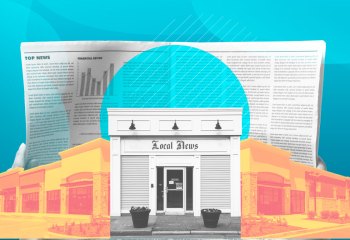
6 key takeaways from Knight Media Forum 2021
For 14 years, the Knight Media Forum has been a place for funders, journalists and community leaders to discuss ways to create more informed and engaged communities, promote free speech and free press, and explore the rise of disruptive technology. In 2021, the forum’s first virtual convening set these topics against the events of the past year, with timely panels on systemic bias among foundations and media publishers; the continued rise of mis- and disinformation; and how place-based foundations are supporting struggling local newsrooms, during the pandemic and beyond.
Knight Foundation President Alberto Ibargüen opened the conference by addressing the urgent need to support local news in many communities, especially during COVID-19.
“At Knight Foundation, we’ve chosen to focus on finding sustainable models that will deliver consistently reliable news digitally and locally,” Ibargüen said. “We made that choice because digital is where the crowd is, and because local journalism is a way to build community cohesion and community bonding. Good local journalism is also how you build trust in institutions, including in the media itself. A citizen can trust local news—but they can also verify. They need only step outside their homes to judge the quality of the report.”
Here’s an overview of some of the top takeaways from the forum.
1. Media organizations and funders have work to do to eliminate bias.
From advocating for media reparations, to having more people of color shape journalism funding decisions, speakers spoke about a range of ways to eliminate bias. One of the highlights of the forum was the panel discussion, “Dismantling Systemic Racism,” with women of color demanding more action to make the media more inclusive. Alicia Bell, who heads the timely Media 2070 project at Free Press advocated for media reparations and noted that “we need a comprehensive plan for racial justice and equity for futures that are full and abundant with Black liberation and Indigenous sovereignty.”
Authors Isabel Wilkerson and Thomas Chatterton Williams spoke about their experiences with racism and the challenges in creating a more equitable society. Wilkerson, the Pulitzer Prize-winning author of “Caste: The Origins of Our Discontents,” stressed the gravity of the attack on the Capitol on Jan. 6. It was not a betrayal of what America stands for, she said, but rather “the consequences of unaddressed history.
“Everyone, particularly journalists tasked with explaining the world to our country, have a responsibility to understand the history,” Wilkerson said.
2. Finding the “funding deserts” can help identify needs in underserved communities.
We hear a lot about news deserts, places that don’t have local newspapers covering local issues, but we haven’t heard a lot about “funding deserts,” typically rural or communities of color that don’t have a lot of wealth or funding for news. Field Foundation’s Angelique Power talked about the mapping project the foundation produced in Chicago, showing that underserved communities on the West and South side received only 6% of grants in the city. Impact Architects released an ecosystem study of one state, two counties and six cities to better understand “the health of the local news and information ecosystems through a baselining of the communities, information providers, and the relationships among them.” It also included a playbook for other communities to use in gauging their own news ecosystems. These reports add crucial data to the struggle for publishers to serve accurate, trusted news and information into communities of color – and help make them sustainable.
3. Telling human-centered stories helps communities heal and combat misinformation.
Elisabeth Rosenthal of Kaiser Health News noted that these types of narrative stories are much stronger than fact-checks against disinformation, particularly when talking about COVID-19. “Facts are cold and people are warm,” she said. “We need to make facts much warmer.”
Bell mentioned that marginalized communities need to stop coming from a place of scarcity and “reimagine how we share power with one another, and create new models.” Roxann Stafford at Lenfest Institute brought up the same point, noting that the AI for the People project she helped fund in Philadelphia helped tell stories that center the experiences of people in the community, letting them speak in their own voices and offering “hope and upliftment.”
4. It’s time to hold social media and technology firms accountable for the societal harms they perpetuate.
There was a time when people thought about Google, Facebook and Amazon as disruptors who were changing the world for the better, bringing people together online in new ways. But now a growing chorus of citizens, lawmakers and regulators around the world see the damage they have done by allowing hate speech and disinformation to flourish. Plus, Australia has fought tech platforms with a new law to have them compensate news providers for profiting off their stories. Microsoft’s Brad Smith noted that his company supported the new law and when Google threatened to pull out of Australia, Microsoft offered up Bing as an alternative – which led Google back to the negotiating table for a deal. As Tristan Harris of the Center for Humane Technology put it: “Social media companies have profited off the backs of journalism… while degrading the entire ecosystem of journalism. These are the richest companies in history and we should have a well-funded Fourth Estate around the world – funding from tech companies would be helpful.”
Knight’s Ibargüen noted at the forum that technology has amplified the tensions between free expression and building a more inclusive society, and urged that policymakers revisit laws concerning content moderation.
“Given the current moment’s combination of social and tech upheaval, it’s time for society to review and update our guidelines, our limits, and our understanding, for the digital age,” Ibargüen said.
5. Community foundations play a growing role in collaborative fundraising for local news.
Knight Foundation has spent years trying to grow the number of place-based foundations who support local news in their communities. One interesting trend is the role of community foundations in pooling funds from various philanthropists to support critical news and information. Ashley Swearingin of Central Valley Community Foundation talked about the collaborative effort by local funders in Fresno, Calif., to support the Fresno Bee and other local journalism and community engagement initiatives. The Impact Media and Measurement Fund has raised more than $1.6 million so far.
As Revson Foundation’s Julie Sandorf pointed out recently, if every foundation gave 2% of its grant making to local news, that would total $1.5 billion and make a huge difference.
6. To fight the infodemic, we need broad coalitions of researchers, journalists, policy makers and citizens.
As mis- and disinformation has spread on social media from the 2016 U.S. election through the pandemic and vaccination efforts, we need more groups from more backgrounds to work together to counter it. The bad news is that there seems to be more misinformation than ever online; the good news is that the collaborative efforts of groups such as The Virality Project and First Draft News can make a difference. As Jevin West at the Center for an Informed Public at University of Washington said: “I’ve seen more so than any time in my career groups coming together and putting aside differences and sharing data and research. It’s a beautiful thing to see.” West noted that one researcher who studied the collective behavior of fish was now applying that to the behavior of people online.
The Virality Project, run out of the Stanford Internet Observatory, focuses on COVID-19 vaccine misinformation, and comes on the heels of the successful Election Integrity Partnership to detect and react quickly to misinformation as it happens. What they all have in common are broad coalitions of researchers, journalists and public policy makers who can make sure their work has a deep impact. And First Draft News’ Claire Wardle noted that efforts have to involve the public too, so it’s not left to academics and elites. “We had five fellows in battleground states and they were our eyes and ears and the scale was incredible…From a funding perspective it’s hard to scale but you have to have people on the ground.”
Mark Glaser is a consultant and advisor with a focus on supporting local and independent news in America. He was the founder and executive director of MediaShift.org, and is an associate at Dot Connector Studio, and innovation consultant at the New Mexico Local News Fund.
Recent Content
-
Journalismarticle ·
-
Journalismarticle ·
-
Journalismarticle ·









